Program Delivery
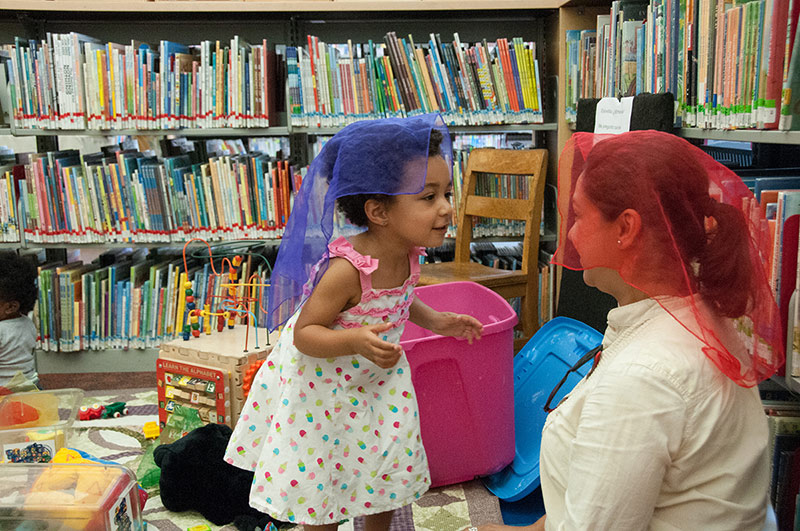
Now that you’ve completed your program design and outreach, you’re ready to deliver your Stay & Play program series. You’ll need to create a welcoming environment in how you set up the room, greet and interact with both children and adult participants, track attendance, provide play activities, conduct storytime, share resources, and include food — all the elements that together make this a Stay & Play program.
After each session, you will also need a plan for the close-down: clean up and put away materials, assess what supplies and or materials need to be replenished, and plan for continuous improvement (described in the evaluation section). Be sure to refer to the Case Studies webinar slides for specific examples of how to run a Stay & Play program.
Create a Welcoming Environment
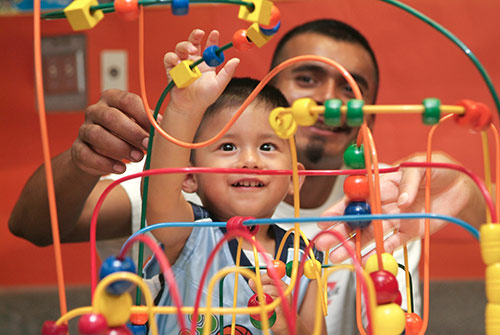
Set up the space beforehand so you are ready to engage with the children and their care providers as they arrive. Strive to create an inviting space where children can discover joy in learning and investigation while their caregivers can feel included and welcomed. Offer an array of experiences to ensure children of many ages will have multiple ways to play, learn, and interact with other children and adults. Intentionally setting up a place to play also provides an additional opportunity for family, friends, and neighbor child care providers to connect with and enjoy being with their children. Pilot sites also found that intentionally creating a quiet corner allowed children to enter the group activities at their own pace.
For inspiration see Designer’s Tips for Creating Child and Family-Friendly Library Spaces on the Elf Website. Remove fragile items that could break or can’t be touched, unsafe things that might invite unsafe climbing, and electrical cords or uncovered outlets. Doing so helps to minimize the need to say “no” and gives children more freedom to explore the environment without interruptions. A “dirty toy” bucket allows participants to identify when things need cleaning and a countertop dishwasher can ensure that toys and dishes are clean and sanitized between sessions.
Greet and interact with participants using a strength-based, relationship-focused approach. Being genuine and authentic in a spirit of walking alongside children and caregivers, in which staff seeks to learn from them, goes a long way to build trusting relationships that will endure and bring people back to the library. It also offers an opportunity to model nurturing adult-child interactions that support early learning development.
Track attendance
Tracking participation can help you understand your audience and document participation. One library tracked attendance by creating name tags that caregivers picked up each time they arrived. Every time they attended a Stay & Play, providers put a new sticker next to their name. This method helped staff track attendance over time, without having to collect names, phone numbers, or other identifying information. The library found that it also helped build caregiver relationships as participants and staff got to know each other’s names.
Provide Play Activities
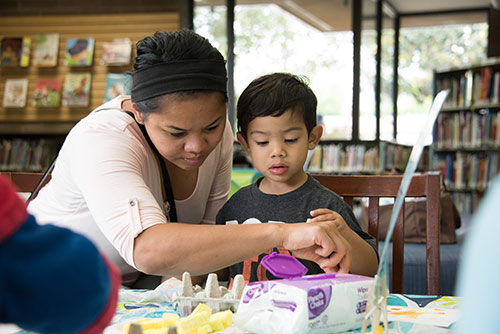
Play is a core feature of this program so it is very important to be intentional about your play supplies. Keep in mind that some of the simplest toys are the best and in fact you may not need a big budget to have a quality play experience for children. Natural materials, baskets, wooden toys, cardboard boxes, photos of real people and things (instead of cartoons) can create a delightful play collection. When creating your toy collection, balance “special” more expensive materials with things that can be acquired or made at home, which can be replicated by caregivers in their home environment.
A variety of toys and learning materials that develop different skills and allow children to work both together and individually are ideal. Pilot libraries found that setting up a variety of play stations gave children choices for what they wanted to do, how they wanted to explore the toys, and with whom.
How library staff interact and play with children can model and encourage caregivers to join in the play as well. Play at its most fundamental is about supporting a child’s curiosity. Following the child’s lead, getting down to the child’s level, not interrupting, being curious, asking occasional questions rather than instructing — all go a long way to supporting meaningful play. Honoring opportunities for childrens’ independent play gives caregivers time to support one another and build a caregiver network.
Some libraries created learning tip sheets for caregivers that were helpful in guiding staff and volunteers for select activities. These tip sheets often included information about how to replicate activities and materials, such as playdough, at home, and were translated into applicable languages. The principles found in The Five Practices And The Early Literacy Components Support Each Other guided choices of activities used by two pilot libraries which are explained in the Case Studies webinar.
Here are some ideas for toys:
- Puppets: Engages multiple children at once and gives opportunities to create stories
- Soft blocks: Enjoyed by a broad range of ages and allows for open-ended play
- Found materials (paper towel tubes, plastic containers, cardboard boxes): Easy to replicate at home, builds caregiver confidence and supports the development of children’s creativity
- Dollhouse and dolls: Builds empathy and provides opportunity for pretend play
- Play Kitchen: Promotes pretend play, problem-solving, and cooperative play
- Wooden “rocking boat”: Flexible piece that helps build gross motor skills and encourages cooperative play and singing songs like “Row Row Row Your Boat”
- Balls (alone or combined with tubes): Encourages interaction and helps children explore cause and effect
- Sensory toys (e.g. kinetic sand): Promotes motor development and can be calming
Conduct Storytime
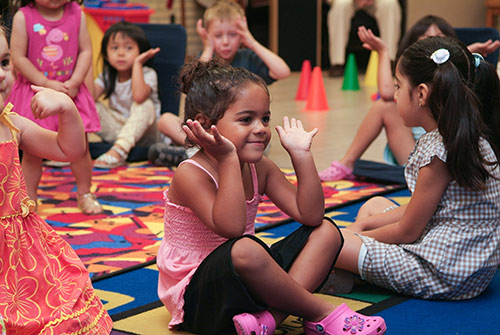
Libraries have long known the value of storytime and have a great deal of experience delivering meaningful storytimes that engage young children and families. There are a few things that make Stay & Play storytime unique:
- Most pilot sites found that they could read only two books during each session, although it was important to have multiple books prepared to choose from in order to respond to the specific audience that showed up on a particular day.
- Have readily available seating for grandparents, elders, and folks who can’t sit on the floor so that caregivers can be near their child.
- Prepare songs in advance. It is helpful to have songs you repeat each time (e.g. for opening, closing, and clean-up). Make sure to choose culturally appropriate songs and to encourage caregivers to participate.
- Encourage staff to have flexible expectations to take the pressure off of them and the participants. Let caregivers know it’s ok if children don’t appear to be listening, even allowing them to play in the background. This “listening while doing” allows children to slowly enter into the storytime routine when they are ready.
- A designated storytime area and rituals can help children transition from free play to storytime, such as singing a special clean up song followed by a call to the rug, [set casual expectation and continue flexible tone], encourage caregivers to model involvement.
- Present the stories in more than one language if staff skills or community volunteer skills allow. In a large group, you might consider projecting a powerpoint slide with the translations. Don’t be afraid to ask volunteers or even the caregivers themselves to help translate.
- Spend time introducing storytime and modeling for the other adults how to facilitate and participate. You can even invite adult participation by asking them if they’d like to share a song or tell or read a story.
- Remember to extend storytime by including books in free-play time or in activity kits to send home.
Share Resources
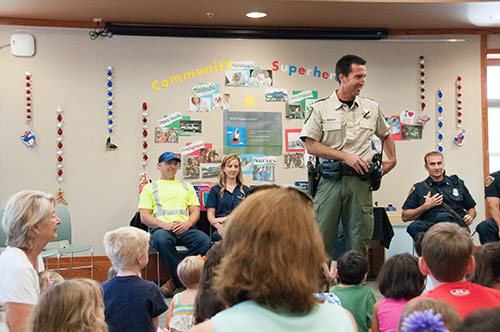
As you get to know the participants and learn their needs and wants, you will be able to highlight library resources and community experts they are most interested in and materials they can use/checkout to extend learning at home. You may be able to develop your library collection to specifically benefit Stay & Play participants.
Being intentional about the resources and activities you offer as well as the community expertise you bring will help showcase possibilities and develop connections/networks for FFN. It sends the message that the library is here to support them, a place where they can ask questions. Bringing in an outside community expert can also help inform staff, as well. However partnerships with outside organizations require thoughtful planning in which goals, expectations, and roles of each party are identified and shared.
Ideally, during the community-assessment stage of planning, you will have considered many potential partners in your community, including experts, and you will have identified the people and types of organizations that FFN in your community would like to hear from. These lists will grow with your program but the assessment, along with in-house resources, gives you a place to begin. Remember that caregivers themselves are experts with lots to share with their community.
If you do bring in outside partners and experts, start slowly. Build partnerships as you establish your library’s Stay & Play and get to know the informal child care providers in your community. It is important to set the stage and let partners know what to expect (tips on how to engage toddlers, an orientation to the Stay and Play format, demographics, languages needed for handouts, format, environment, and noise level, the types of questions they might be asked, etc.). Be aware of replicating what’s already out there (no one wants to hear from the same group that pops up everywhere).
Here are some tips from the pilot libraries:
- Instead of a lengthy presentation, have a brief introduction followed by time for caregivers to connect with the presenter one-on-one (either at a table, or circulating during open play).
- Encourage outside guests to bring a hands-on demo (or give direct suggestions for types of activities that could be used).
- Evaluate the content before the community partner arrives.
- Some examples that worked well: a speech therapist did a short presentation and then offered individual screenings while families played or an Early Childhood Educator did a segment on play and then played with the caregivers and kids.
- Staff introduce any outside experts/community partners (rather than having them introduce themselves at the start of the program).
- Make sure to include in the introduction how the partner can be of use to the community and to connect their expertise to what the caregivers will find valuable.
- Be sure any materials are in the language that meets the needs of the FFN in your community.
- Keep it casual and allow people to come up and chat freely with the community partner.
- Invite partners to participate in story time and play time. It creates an environment where families feel comfortable with community resource providers and can ask questions freely.
Include Food
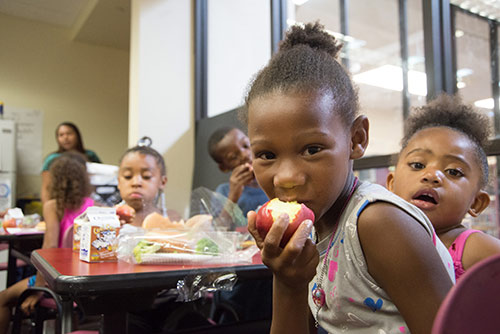
Food plays a special role in connecting people. Sharing food creates community and reinforces a common experience within the group. It eases a caregiver’s busy day and helps them provide for the children in their care in a way that allows caregivers to stay longer and be relaxed. Young children need to eat often and having food available makes the library a more friendly and welcoming place for people with young children. Caregivers do not need to elaborately plan around or disrupt mealtimes in order to participate. Work with caregivers around food allergy safety. When the program is already acknowledging the expertise of caregivers, caregivers will be able to speak up with confidence for the needs of children in their care.
Work with your administration to outline policies around allowing food in the library. Some of the pilot ibraries allowed food throughout the library while others were able to get permission to allow it in ertain rooms or for certain programming. If your policies will not allow food of any kind in the library, ou could try to get fresh food from the food bank and allow caregivers to take it home with them. egardless, it is important to get informed about your library’s policies and get creative!
There were four different schedules that the pilot libraries used to facilitate food during Stay & Play:
- Openly available: One pilot put out a basket of prepackaged food, water bottles, and juice boxes. They placed it at the front table so caregivers could come back and get snacks as needed.
- End of program: One pilot would provide snack time after their program, in a structured way. For many, this was the signal that the program was wrapping up. Then, caregivers and children could linger or leave as they wished.
- At the start: One pilot started their programming with a snack at the beginning. This allowed for everyone to feel full and helped children concentrate for the remainder of the programming.
- Only from home: One pilot let caregivers and children eat their own food when needed, but did not provide food from the library.
Tips from the pilots:
- Be sure to let families know you will be having food at your program and encourage caregivers with children with dietary restrictions to bring their own.
- Prepackaged foods (goldfish crackers, graham crackers, water, juice boxes, etc.) allow for parental choice and can help with food sensitivity issues if families did not bring their own.
- Make sure there is an ingredient label for the prepackaged food you choose and/or label any containers with food items that you have out to help caregivers make the best choices for their children.
- Look for sustainable food funding (program budget, Friends, external funding, etc.). Be sure to check the policy of your program’s funding streams to understand if there are any rules around food and beverage purchasing.
- Be ready to approach your funders to request exceptions to amend existing food policies. In some libraries, purchasing must be done through a process that could cause delays, so it’s best to plan ahead.
- Some of the healthier snacks to provide (e.g. fresh fruits) are challenging to store and prepare. If your library does not have a place to store perishables, prepackaged foods may be a better choice because they are more manageable, cost effective and eliminate food contamination. Some pilot libraries would buy in bulk ahead of time and let attendees know what to expect.
- Have a suggestion box to understand the needs of your audience (e.g. one library bought coffee beans and later learned the families preferred instant coffee). Have families take responsibility for cleaning up after themselves. Include children in the clean-up activities and have ample trash cans and cleaning supplies available.
- Make sure to have a plan for handwashing both before and after food distribution. See Center for Disease Control website for resources and recommendations about handwashing.
- Designate certain areas for eating or create a snack table as a quiet space for children that they can navigate independently.
- Have a play kitchen, pots & pans, vegetable toys, tea set, broom, vacuum, etc. available for children to explore habits around preparing food and cleaning up afterwards.
When in-person programming isn’t feasible here are just a few ideas for supporting Stay & Play:
- Outreach: Create a specific hub on website and social media for caregivers with links to library and community resources.
- Play: Create toy bags to support play at home.
- Storytime: Offer and link to online storytime options.
- Resources: Create activity kits for caregivers and young children. See Case Studies webinar and reimagining school readiness toolkit for ideas.
- Food: Reach out to the local Food Bank, Food Shelf, Health and Human Services (CalFRESH and WIC), grocery store or co-op. Not only could they be a source of food, but they may also want to provide information or run programs on healthy eating. Talk with other libraries that are offering “Lunch at the Library” programs for ideas on distributing food. If you are offering curbside pick-up of library materials or storytime kits, see if you can include prepackaged foods as part of the program.
